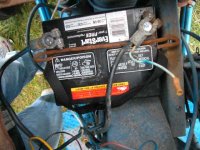John, I agree with Beenthere that your positive terminal looks like it is touching the hold-down clamp, but it doesn't look like it's hooked to anything. If you strap it down with a non-conductor, there will be no direct short, but if the strap gets wet or dirty, you could have a "bleed" type low current short.
The best method is to make sure your terminals do not touch any metal and keep the top of the battery clean and free of moisture.
If you want to find your short that is discharging your battery, remove the positive terminal and hook up an ohmmeter to it (black, neg, test lead to ground; red, pos, test lead to the removed positive terminal). Put the ohmmeter on the highest scale and see if the needle deflects. If it does, you are going to discharge your battery with a trickle bleed. As you noted in another post, the battery sparked when you connected the negative terminal. It should not do this.
With your meter connected, start removing wires one at a time to trace where the problem is located. If the meter shows infinite resistance when you remove a wire, you are on the right track. I'd start at the alternator. The other place that can bleed your battery is a partially shorted bad solenoid. Just use your logic to work throuh the system until you find the part that gives deflection on the meter when connected, but is open when removed.
To check your ammeter, just disconnect the wires and hook them together so they bypass the ammeter. If the problem goes away, your ammeter has an internal short to ground. To isolate the solenoid, remove the wire coming from the battery and the smaller wire. Hold these wires together so the rest of the circuit is complete. If you lose the short, look at your solenoid as the cause of the problem. If the 6-volt solenoid has been retained, it may be suffering from the additional starting current provided by the 12 volts. Just keep going and isolate/bypass one component at a time and you will locate your problem. /forums/images/graemlins/cool.gif
Don't forget to look at the connections to the ignition switch. There are lots of wires there in a small space, /forums/images/graemlins/tongue.gif and they could be touching.
